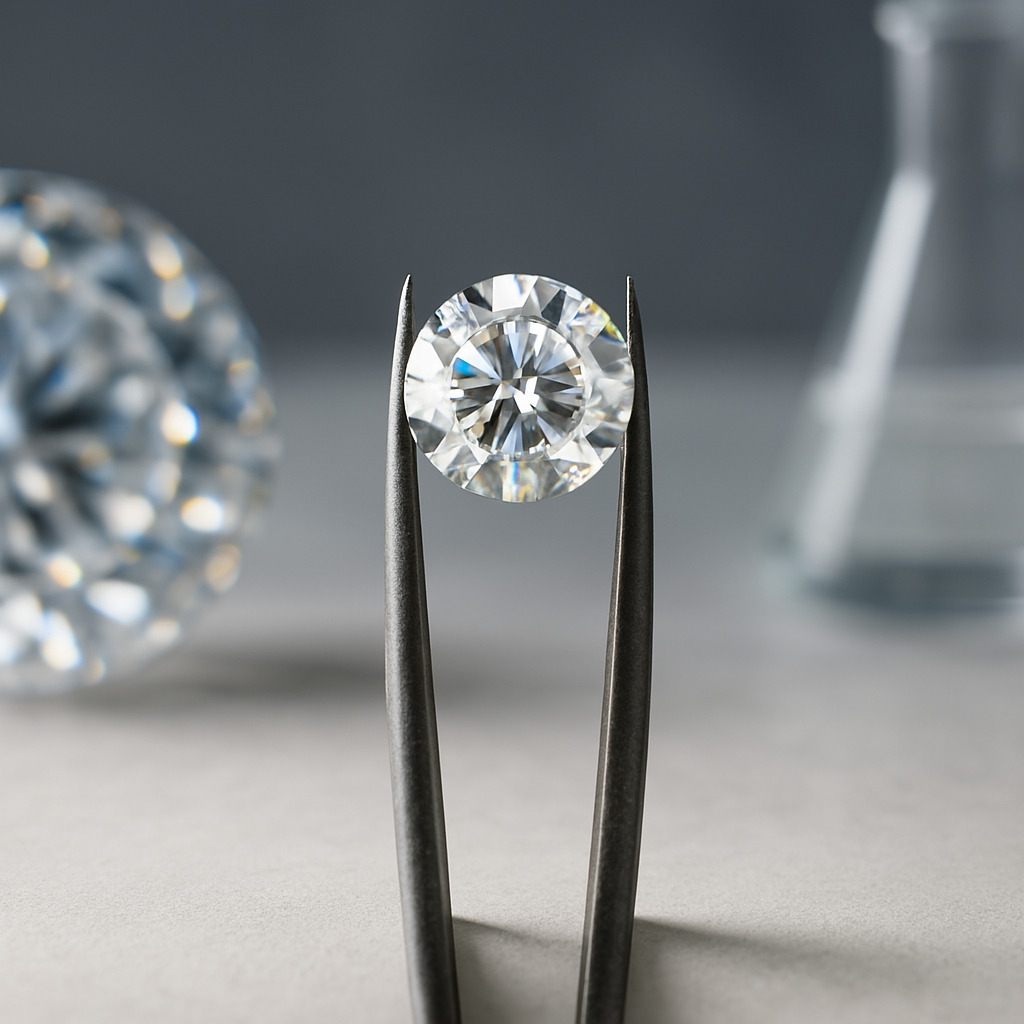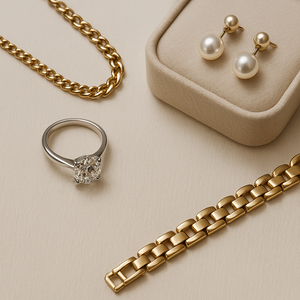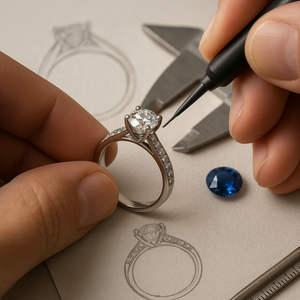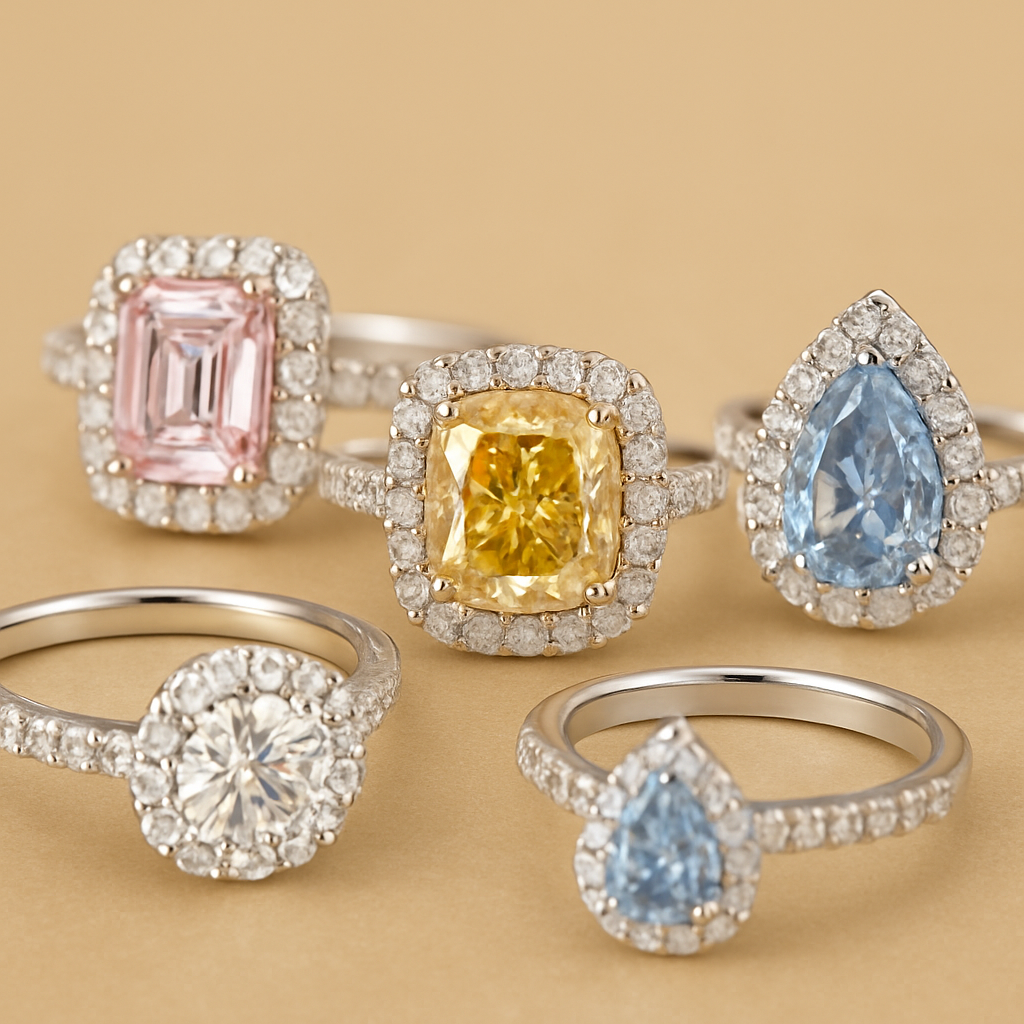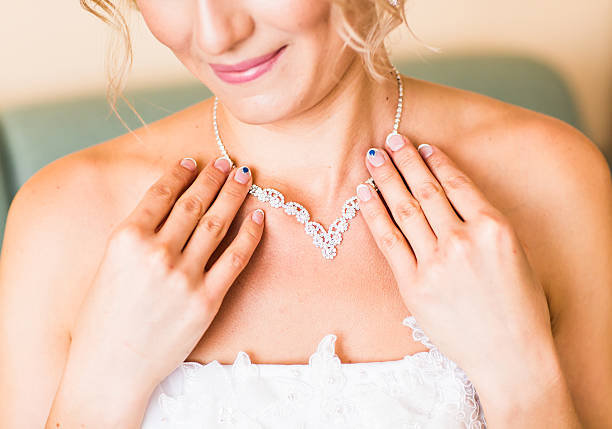Today's consumers seek value, ethics, and transparency in addition to beauty. Lab-grown diamonds can help with that. These stunning stones represent a revolution in luxury and are physically identical to diamonds that have been mined. Lab-grown diamonds are setting the standard for luxury jewelry as we move into a future where sustainability and individuality are commonplace.
🔬 What Are Lab-Grown Diamonds?
Two innovative approaches are applied to produce lab-grown diamonds, which are referred to as man-made, engineered, or cultured diamonds, in a laboratory environment:
HPHT (High Pressure, High Temperature) replicates the natural geological process of diamond formation beneath the earth's crust.
Chemical Vapor Deposition (CVD): Diamonds are grown layer upon layer in a carbon-rich gas chamber.
👉 Fact: Lab diamonds are graded by renowned gemological laboratories such as IGI and GIA and are 100% carbon, just as mine diamonds.
They possess:
Same hardness (10 on the Mohs scale)
Same fire, brilliance, and clarity
Same physical construction and refraction of light
The only difference? They grow above ground, not below.
❌ Busting the Biggest Myths About Lab-Grown Diamonds
Lab-grown diamonds remain wrapped in mystery and outdated assumptions despite their growing popularity. Let's eliminate the most prevalent myths so that you can make informed choices.
🧪 Myth #1: Lab-Grown Diamonds Are Fake
Reality:
This is arguably the most universal myth and the one that is most disconnected from reality. Unlike moissanite or cubic zirconia, lab-grown diamonds are not imitations. Since they are composed of pure carbon atoms arranged in the same crystal structure as natural diamonds, they are authentic diamonds.
They are so similar that even professional gemologists require specialized testing to distinguish between them.
⌛ Myth #2: Lab-Grown Diamonds Don’t Last Long
Reality:
Similar to mined diamonds, lab-grown diamonds have a Mohs hardness of 10. By doing this, they are incredibly strong, scratch-proof, and appropriate for daily use. Your lab-grown diamond will last a lifetime and beyond, just like a mined one, whether you're purchasing a ring, earrings, or bracelet.
💰 Myth #3: Lab-Grown Diamonds Have No Resale or Investment Value
Reality:
Although the market for resale of traditionally mined diamonds has been stronger, the increasing demand for lab-grown diamonds is opening up new opportunities for resale and second-hand marketplaces, particularly for certified and premium stones.
Additionally, the majority of consumers today place a higher value on sustainability, ethics, and personal meaning than resale value, particularly when purchasing engagement rings and other personalized gifts.
🔥 Myth #4: They Don’t Sparkle Like Natural Diamonds
Reality:
If you've ever had the chance to see a lab-grown diamond with your own eyes, you know this just isn't the case. Since many lab-grown diamonds are made with better cuts and fewer inclusions, they sparkle just as brilliantly, if not more, because they are optically identical.
💎 Our lab-grown diamonds at San Liora are hand-picked for their brilliance and fire, providing premium shine at a fraction of the cost.
Lab-grown diamonds aren't just real—they’re revolutionary. Don’t let myths stop you from experiencing modern luxury with a conscience.
🌍 The Ethical & Environmental Impact
Consumers today are becoming more conscious about where their goods come from—and the real price behind the shine. The luxury jewelry market is no different. While diamonds have long been used to represent love and eternity, the natural diamond mining process has raised some tough ethical and environmental questions. Lab-created diamonds present a new, conscious option that resonates with values of sustainability, equity, and transparency.

💥 The Hidden Cost of Mined Diamonds
Even though they are beautiful, historically mined diamonds usually come with a high price to the earth and its inhabitants:
1. Environmental Degradation & Land Displacement
- Mining involves the excavation of massive amounts of rock and dirt, sometimes more than 250 tons per carat.
- This disrupts landscapes, leads to deforestation, and displaces native wildlife.
- After the land is cleared, it will never return, and it will have lasting damage to ecosystems.
2. Water Pollution & Waste
- Extraction of a single carat of diamond can take 100+ gallons of water.
- Polluting runoff from mines can contaminate surrounding rivers and groundwater, damaging local agriculture and communities.
- In water-constrained countries, this presents very serious humanitarian issues.
3. Carbon Emissions
- Mining diamond operations are power-hungry, relying on fossil fuels to drill and transport.
- The carbon footprint of diamonds mined is considerably greater than laboratory-grown equivalents, with contributions to climate change.
4. Human Exploitation & Conflict
- In certain parts of the world, mined diamonds have been associated with "blood diamonds"—stones used to finance armed warfare and rebel uprisings.
- Numerous diamond mines suffer from depleting labor conditions, subjecting employees (children included) to hazardous conditions with meager pay or safety measures.
- Problems such as forced labor, minimum wages, and hazardous working conditions continue to be reported in various mining areas.
🌱 Why Lab-Grown Diamonds Are a Better Choice
Lab-grown diamonds provide a far cleaner and more ethical option—without compromising on quality or beauty.
1. No Mining, No Destruction
- Because lab-grown diamonds are grown in a laboratory setting, there is absolutely no excavation.
- No trees are felled, no ecosystems disturbed, no wildlife relocated.
✅ Outcome : A minimal environmental impact compared to conventional mining.
2. Water & Energy Efficiency
- Producing a lab-grown diamond consumes up to 85% less water and 60% less energy per carat.
- Most lab facilities are increasingly turning to renewable energy sources, further lowering their carbon footprint.
- In contrast, mining continues to rely substantially on diesel and other fossil fuels.
✅ Outcome: An environmentally friendly solution that promotes responsible use of resources and climate action.
3. Conflict-Free & Child Labor-Free
- Lab diamonds are assured conflict-free—neither do they come from war-torn areas nor do they come from oppressive governments.
- These diamonds are cultivated in controlled laboratories, usually in nations with strict labor laws and ethical business standards.
✅ Outcome: Peace of mind that your diamond didn't come at someone else's expense of safety, rights, or life.
4. Transparency & Traceability
- Lab-grown diamonds are completely traceable, with open documentation of where, when, and how they were produced.
- Most are supported by sustainability certifications (e.g., CarbonNeutral®, SCS-007 Sustainability Rated Diamond Standard).
- This makes it possible for buyers to make decisions wisely with full openness.
✅ Outcome: A purchase based on your values of responsibility, honesty, and trust.
💸 Affordable Without Compromise
Diamonds have always symbolized love, but their price tag? Not so lovable.
💎 Lab-grown advantages:
- Up to 60% more affordable than mined diamonds.
- Enables shoppers to choose:
-
- Bigger stones
- Higher clarity grades
- Rare shapes or fancy colors
- Perfect for custom engagement rings or statement pieces
💬 “With lab-grown, you’re not compromising on quality—you’re elevating your options.”
🎨 Limitless Design Possibilities
With lab-grown technology, designers no longer have rarity or supply constraints:
- Access to specialty fancy colors (blue, pink, yellow) at a fraction of the price
- Option to create perfect symmetry, flawless cuts, or precision-matched earrings
- Quick turnaround on customization—from idea to creation in weeks
San Liora leverages this flexibility to create unique, narrative-driven collections you won't see anywhere else.
💫 Loved by Celebrities & Industry Leaders
Increasing numbers of celebrities and brands are getting on board with the lab-grown revolution:
- Emma Watson, Zendaya, and Leonardo DiCaprio (who invested in a lab-grown diamond business) back responsible jewelry.
- International brands Pandora, De Beers (Lightbox), and Vrai now carry lab-grown collections.
- Fashion weeks and red carpets are now showcasing lab-grown shine.
It's not just a trend—it's a cultural shift.
📈 Market Trends & Consumer Preferences
The diamond industry is evolving—and quick.
🔍 Latest Facts:
- The lab-grown diamond industry is on track to reach $55 billion by 2031.
- More than 70% of Millennials and Gen Z indicate they'd choose a lab-grown diamond for environmental and ethical purposes.
- Retailers document doubling of sales of lab-grown diamonds year by year.
💡 Gen Z is the most eco-aware generation to date—and they're making their opinions count.
🔗 Ready to Embrace the Future?
✨ Discover our breathtaking, eco-friendly lab-grown diamond collections.
💍 From wedding rings to daily sophistication, San Liora creates responsible luxury beautifully elegant.


